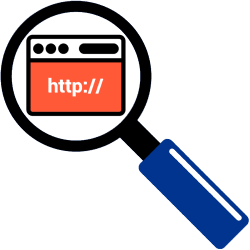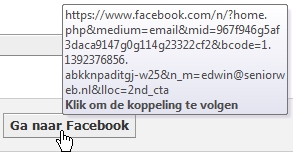
Not sure if an email is phishing? Sometimes just looking at the URL is enough to tell you not to click.
Fishing for credentials
Criminals are fishing for your data. They love your online banking and DigiD login codes or your debit or credit card details. They use an email message as bait, hoping that you will click a link in the email and then enter your code. This is called ‘phishing’.
Phishing messages look more and more real, and are therefore more and more difficult to spot. But there’s a handy trick for that. You control – without click on the links in the email! – where the links in the email point to. If they point to a known website, the mail is genuine, if they point to an unknown address, it’s phishing. Check a link like this:
Check link in program like Outlook or Mail
- Open the email you suspect is phishing.
- Move the mouse pointer about a link in the message.
- You will now see the full address to which the link points. In the example picture below that address starts with https://www.facebook.com/
- We can see from the Facebook website that Facebook does indeed have the address www.facebook.com. So this link is real.

In the future you can check whether the links in an e-mail point to a reliable page on the Internet. You can see what the web address should look like on the website of the institution or bank. For example, an address of ABN Amro starts with ‘https://www.abnamro.nl’.
Check link in webmail
- Open the email.
- Move the mouse pointer about a link in the message.
- The full address to which the link points is now displayed in the status bar at the bottom of your browser. In the example picture, that address starts with https://www.facebook.com/
- We can see from the Facebook website that Facebook does indeed have the address www.facebook.com. So this link is real.

In the future you can check whether the links in an e-mail point to a reliable page on the Internet. You can see what the web address should look like on the website of the institution or bank. For example, an address of ABN Amro starts with ‘https://www.abnamro.nl’.
Recognize Phishing
Of course there are more points to pay attention to. Sometimes you immediately recognize phishing by the spelling mistakes or the weird salutation and you don’t even have to use the above trick. You will find a checklist for this in the article Phishing: don’t fall for it!.
Do you still have doubts about the authenticity of an email? Then don’t click on a link in that message. Contact the bank or agency. Or surf to the page of the bank or institution and log in as you always do.
Phishing checker for members
Fake e-mails remain difficult to recognize. SeniorWeb members can forward suspicious emails to us. You will hear at the latest the next working day whether it is a phishing email or not.
Go to the SeniorWeb Phishing Checker